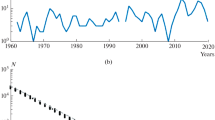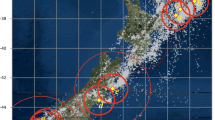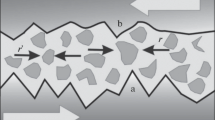Abstract
Aftershocks or swarms indicate increase of the flow intensity in the vicinity of the initial earthquakes. By normalizing their number according to the dynamic range of the standard frequency magnitude distribution the increase or positive aftereffect property of the initial earthquakes can be compared for different magnitude intervals, periods of time or regions. After applying accurate formal algorithm of aftershock identification it is possible to study negative aftereffect of the main events (nonaftershocks) in the catalog.
Negative aftereffect means decrease of the probability of successive events in a time-space vicinity of the main event, when the aftershocks are over. The negative effect is the most important part of the seismic cycle and seismic gaps approach. Global statistical test give high confidence level for the relative decrease in intensity of the flow of the events withM≥7 in the first 20–25 years after the events withM≥8 in their 1o-vicinities in the total time period under study of approximately 60 years. The decrease approximates 32% of the undisturbed intensity of the flow ofM>7 events in the vicinities.
Self-similar negative aftereffect was observed 3–7 years after 6≤M<7 events, it totals approximately 18% of the undisturbed intensity. Another type of self-similarity of seismic regime, with respect to the negative aftereffect, is the decrease of probabilities of aftershocks with large magnitudes in aftershock sequences. When we have adequate dynamic range in the catalog for the study of this property, for example, for main events withM≥7 in the catalog with low cut-off limitM=4, the statistical significance of the negative aftereffect is clear. However, the absolute value of the effect is also rather small, about 10%, which means that in 90% of the cases the aftershock sequences do not experience lack of energy due to the main shock energy release and follow a standard magnitude distribution for earthquakes in the entire catalog.
The small values of the negative aftereffect apparently indicate partial stress relase by earthquakes and may explain short recurrence time intervals after major earthquakes observed periodically in different places.
Similar content being viewed by others
References
Abe, K. (1981),Magnitudes of large shallow earthquakes from 1904 to 1980, Phys. Earth Planet. Int.27, 72–92.
Aki, K. (1979),Characterization of barriers on an earthquake fault, J. Geophys. Res.84, 6140–6148.
Bolshev, L. N. andSmirnov, N. V. (1968),Tables of mathematical statistics (in Russian), Computational Center of USSR Academy of Sciences, Moscow.
Brace, W. F. andKohlstedt, D. L. (1980),Limits on lithospheric stress imposed by laboratory experiments, J. Geophys. Res.85, 6248–6252.
Dmowska, R. andLi V. C. (1982),A mechanical model of precursory source processes for some large earthquakes, Geophys. Res. Lett.9, 393–396.
Duda, S. J. (1965),Secular seismic energy release in the circum-Pacific belt, Tectonophysics2, (5), 409–452.
Fedotov, S. A. (1965),Regularities of the distribution of strong earthquakes in Kamchatka, Kuril islands and northern Japan (in Russian), Trudy Inst. Phys. Earth, AN USSR36, 66–93.
Fedotov, S. A., Chernyshev, S. D. andChernyshev, G. V. (1982),The improved determination of the source boundaries for earthquakes of M≥7 3/4 of the properties of the seismic cycle, and the long term seismic prediction for the Kuril-Kamchatkan arc, Earthq. Pred. Res.1, 153–171.
Gaiski, V. N. (1967),On the similarity between samples of earthquakes interrelations between them and their tendency to periodicity (in Russian), Izv. AN USSR, Fizika Zemli7, 20–28.
Gardner, G. K. andKnopoff, L. (1974),Is the sequence of earthquakes in Southern California, with aftershocks removed, Poissonian?, Bull. Seismol. Soc. Am.64, 1363–1367.
Kagan, Y. andKnopoff, L. (1978),Statistical study of the occurrence of shallow earthquakes, Geophys. J. R. Astr. Soc.55, 67–86.
Kanamori, H. (1977a),Seismic and aseismic slip along subduction zones and their tectonic implications, InIsland Arcs, Deep Sea Trenches and Back-Arc Basins (M. Talwani and W. C. Pitman III, editors), Maurice Ewing Ser. 1 (Am. Geophys. Union, Washington, D.C.), pp. 162–174.
Kanamori, H. (1977b),The energy release in great earthquakes, J. Geophys. Res.82, 2981–2987.
Kanamori, H. andAnderson, D. L. (1975),Theoretical basis of some empirical relations in seismology, Bull. Seism. Soc. Am.65, 1073–1095.
Keilis-Borok, V. I., Podgaetskaya, V. M. andProzorov, A. G. (1972).Local statistics of earthquake catalogs, InComputational Seismology. (Consultants Bureau, New York), pp. 214–227.
Keilis-Borok, V. I. andKosobokov, V. G. (1986),Time intervals of high probability of the world major earthquake occurrence (in Russian), InComputational Seismology 19, (Nauka Publ., Moscow), pp. 48–57.
Kelleher, J. A. (1970),Space-time seismicity of the Alaska-Aleutian seismic zone, J. Geophys. Res.75, 5745–5756.
Kolmogorov, A. N. (1986),Theory of probabilities and mathematical statistics (in Russian) (Nauka Publ., Moscow).
Kostrov, B. V. andDas, S. (1984),Evaluation of stress and displacement fields to an elliptical plane shear crack, Geophys. J. R. Astr. Soc.78, 19–33.
Li, V. C. andKisslinger, C. (1984/85),Stress transfer and nonlinear stress accumulation at subduction type plate boundaries—Application to the Aleutians, PAGEOPH122, 812–830.
Li, V. C. andRice, J. R. (1987),Crustal deformation in great California earthquake cycles, J. Geophys. Res. (in print).
Minster, J. B. andJordan, T. J. (1987),Vector constraints on western U.S. deformation from space geodesy, neotectonics and plate motions, J. Geophys. Res.92, 4798–4804.
Mogi, K. (1969).Some features of recent seismic activity in and near Japan (2). Activity before and after great earthquakes, Bull. Earthq. Res. Inst., Univ. Tokio,47, 395–417.
Mogi, K. (1979),Two kinds of seismic gaps, PAGEOPH117, 1172–1186.
O'Connell, R. J. andDziewonski, A. M. (1976),Excitation of the Chandler wobble by large earthquakes, Nature262, 259–262.
Press, F. andBriggs, P. (1975),Chandler wobble, earthquakes, rotation and geomagnetic changes, Nature256, 270–273.
Prozorov, A. G. (1980),Decrease of probability of occurrence of strong earthquakes in the vicinity of the world's major earthquakes, InComputational Seismology, 11 (Allerton Press Inc., New York) pp. 22–30.
Prozorov, A. G. (1984),On the self-similarity of the frequency-magnitude distributions of aftershocks (in Russian), Doklady AN USSR277, 573–577.
Prozorov, A. G. (1986),Dynamic algorithm of aftershock identification for the world catalog of earthquakes (in Russian), InComputational Seismology 19, (Nauka Publ., Moscow) pp. 58–62.
Prozorov, A. G. andDziewonski, A. M. (1982),A method of studying variations in the clustering property of the earthquakes: application to the analysis of global seismicity, J. Geophys. Res.87, 2829–2839.
Prozorov, A. G. andSabina, F. J. (1984),Study of the properties of seismicity in the Mexico region, Geophys. J. R. Astr. Soc.76, 317–336.
Prozorov, A. G. andSchreider, S. Yu. (1986),Statistical analysis of the positive influence of normal earthquakes of Tian-Shan and Pamir-Alai region (in Russian), InComputational Seismology 19 (Nauka Publ., Moscow).
Reilinger, R. andKadinski-Cade, K. (1985),Earthquake deformation cycle in the Andean back arc, western Argentina, J. Geophys. Res.90, 12701–12712.
Rinehart, W., Meiers, H. andvon Hake, C. A. (1985),Summary of earthquake data base, National Geophysical Data Center, Boulder, Colorado.
Sadovski, M. A., Pisarenko V. F. andRodionov, V. N. (1983),From seismology to geomechanics (in Russian), Vestnik AN USSR1, 82–88.
Sadovski, M. A., Bolkhovitinov, L. G. andPisarenko, V. F. (1987),Deformation of geophysical media and seismic process (in Russian) (Nauka Pub., Moscow) 100 pp.
Sobolev, G. A. (1984),Seismological aspects of the strain field study [abstr.], InSpecial Session of the International Lithosphere Programme (Bogdanov, N. A., editor) (International Geological Congress, 27, vol. IX, Part I) pp. 73–75.
Solonenko, N. V. andSolonenko, A. V. (1987),Aftershock sequences and swarms of earthquakes in Baikal ridge zone (Nauka Publ., Novosibirsk).
Sykes, L. R. (1971),Aftershock zones of great earthquakes, seismicity gaps and earthquake prediction for Alaska and the Aleutian, J. Geophys. Res.76, 8021–8041.
Tajima, F. andKanamori, H. (1985),Global survey of aftershock area expansion patterns, Phys. Earth Planet. Int.40, 77–134.
Thatcher, W. (1983),Nonlinear strain build-up and the earthquake cycle on the San Andreas Fault, J. Geophys. Res.88, 5893–5902.
Tse, S. T. andRice, J. R. (1986),Crustal earthquake instability in relation to the depth variation of frictional slip properties, J. Geophys. Res.91, 9452–9472.
Tullis, T. E. (1986),Friction and faulting, Editor's note, PAGEOPH124, 375–381.
Utsu, T. (1961),A statistical study on the occurrence of aftershocks, Geophys. Mag. (Tokio)30, 521–605.
Vere-Jones, D. (1969),A note on the statistical interpretation of Båth's law, Bull. Seism. Soc. Am.59, 1535–1541.
Author information
Authors and Affiliations
Rights and permissions
About this article
Cite this article
Prozorov, A.G. Effect of an earthquake occurrence on the flow intensity of the subsequent events. PAGEOPH 127, 1–19 (1988). https://doi.org/10.1007/BF00878687
Received:
Revised:
Issue Date:
DOI: https://doi.org/10.1007/BF00878687




